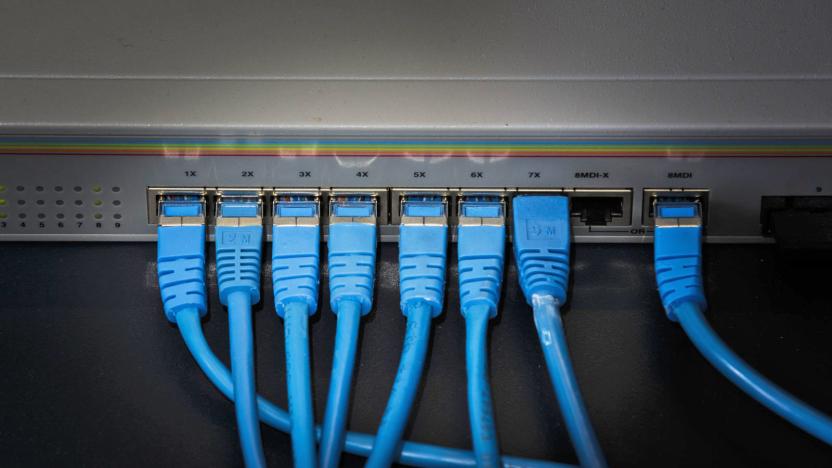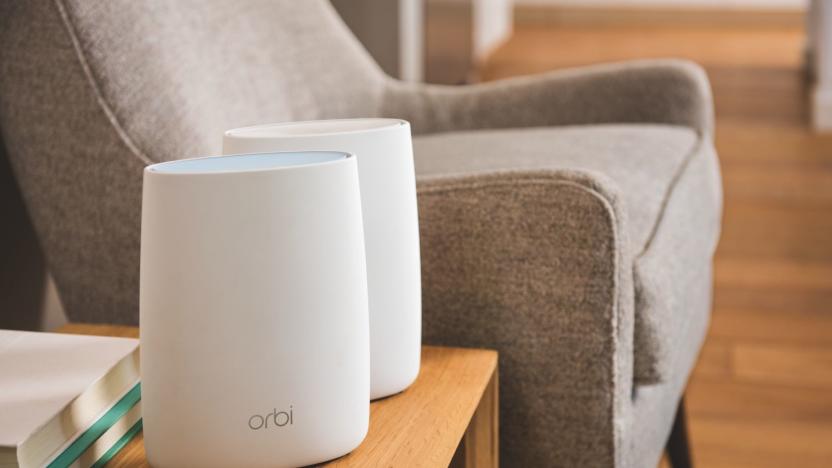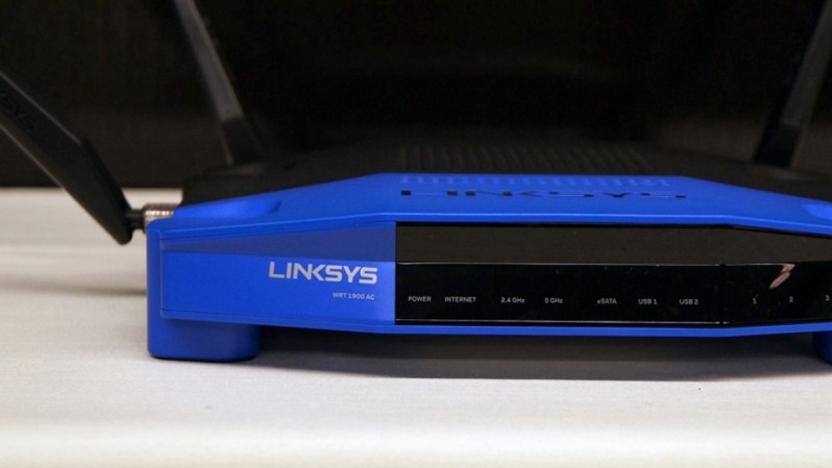router
Latest

Mirai botnet targets Deutsche Telekom routers in global cyberattack
The German Office for Information Security confirmed on Tuesday that not only had nearly a million routers on the Deutsche Telekom (DT) network been recently attacked but that the assault was part of a larger campaign stretching across the world.

Apple reportedly stops making WiFi routers
We hope you weren't dead set on getting a new AirPort Extreme any time soon. Bloomberg sources claim that Apple has "disbanded" its WiFi router division, quietly ramping it down over the past year as team members joined other divisions (including the Apple TV group). Reportedly, the shutdown is meant to "sharpen the company's focus" on those devices that make up the bulk of its revenue. A spokesperson wouldn't confirm the move, but Apple hasn't introduced a new router since 2013 -- it's not as if they had a lot of work on their plate.

Netgear's new Nighthawk router doubles as a Plex server
Video streaming is becoming one of the main things we do on the internet, and few things in life are more annoying than having to wait for a clip to finish buffering. To keep up with our growing appetites for speed, Netgear has unveiled the Nighthawk X10 router, which it says is the fastest in the world. It's got a 1.7GHz quad-core processor onboard that the company says is the speediest in a home router, as well as Quad Stream Wave 2 WiFi architecture that helps the device get up to 7.2 Gbps. Plus, it supports the latest 802.11ad standard. But what's really interesting about the Nighthawk X10 is its Plex Media support that lets you turn any USB 3.0 flash drive or hard disk into a server, without requiring a computer.

Linksys boosts the speed of its customizable WRT router
Linksys has launched a new router in its WRT lineup beloved by WiFi tweaking aficionados. The WRT3200ACM has more bandwidth for its Tri-Band 802.11AC tech, amping the max speed to 2.6 Gbps, double the last WRT model. At the same time, it offers open-source firmware support for OpenWRT or DD-WRT, and no parental controls or other bloatware. It also comes with up to 512MB of DDR3 RAM, eSATA and USB like the last model, making it easier to load and run custom firmware.

Cassia Hub handles multi-room audio with any Bluetooth speakers
We first met the Cassia Hub back at CES, a device that offered the similar connectivity to a WiFi router but for Bluetooth. Now the company is announcing a new feature that will allow owners of that Bluetooth "router" a way to connect their wireless speakers for multi-room audio. The new tool is called BlueStream and it works with any Bluetooth speakers alongside the company's Hub.

Google WiFi is a router that simplifies whole-home wireless
Those rumors of Google giving WiFi routers another shot? They're true. Meet Google WiFi, a router designed entirely in-house... and with a few nice advantages over the OnHub line. Apart from being much smaller (no vase-like design here), its big trick is its ability to create an Eero-style mesh network. You only have to add additional units to your network to improve coverage -- there's a Network Assistant app that makes it easy to add more routers and improve your signal.

Google might introduce another WiFi router on October 4th
We're less than two weeks away from Google's big fall event in San Francisco, and we already have a good idea of what to expect -- Pixel-branded smartphones, maybe Google Home, maybe a 4K-capable Chromecast. Android Police is offering up a new potential bit of hardware we haven't heard about yet: a new router called Google WiFi.

The Linksys EA9500 pierced my apartment's WiFi-proof walls
I live in a two-bedroom San Francisco apartment built in 1916. It has a view of the bay and the top of the Golden Gate bridge. There's crown molding, high ceilings and some pretty dope neighbors. It should be perfect. And it is -- if you're cool with plaster walls blocking 90 percent of all WiFi signals.

MIT's smarter routers promise to fight crowded networks
MIT hates overcrowded networks just as much as you do, and its CSAIL division has made two breakthroughs that could clear up the data pipes. To begin with, it's developing programmable routers that can still keep up with bandwidth-heavy services like streaming video. Instead of trying to create an elaborate rule system for deciding which data packets get through (which could bog a router down or consume a lot of chip space), researchers broke things down into simple computing elements that could handle a wide range of tasks. You'd only have to combine different elements to achieve the intended effect, which could help networks adapt to new conditions -- that hot new mobile game might not cause chaos.

Netgear Orbi promises to rid your home of WiFi dead zones
One of the most frustrating first world problems today is not being able to connect to your home WiFi network in spots that are farther away from your router. Netgear believes it can get rid of that problem with its latest product: a WiFi system called Orbi. The $400 basic kit comprises of a router and a satellite that the company says will cover up to 4,000 square feet together. Orbi's standout feature, said Netgear, is its tri-band mesh system that dedicates one channel to extending the internet from the router to the satellite while keeping the other two free for your other devices' connections.

TP-Link settles with the FCC over risky WiFi router power levels
When the FCC said it was cracking down on WiFi routers that can operate at power levels that might cause interference, it wasn't kidding around. TP-Link has agreed to a settlement with the FCC that will have the company both keep its router power levels in check and shell out a relatively small $200,000 fine. As with Linksys, though, it's not asking TP-Link to block unofficial firmware that could break the rules. Just the opposite, in fact -- TP-Link has agreed to talk to both open source teams (think OpenWrt) and wireless chipset makers to enable third-party firmware that abides by FCC guidelines. While this isn't exactly a back-breaking penalty for TP-Link, it could serve as a warning to other router makers that might veer from the straight and narrow.

BT's Smart Hub router promises stronger, more reliable WiFi
While it's possible to buy and install your own router, most people stick with the one supplied by their Internet Service Provider (ISP). Most are drab and generally underwhelming, both from a design and performance standpoint (please Google, bring your OnHub routers to the UK). BT's Home Hub 5, however, is considered to be better than most. Now, the company wants to build on that reputation with the Smart Hub, a new router that promises a stronger, more reliable WiFi signal at home.

Linksys will let you use open router code under new FCC rules
While the FCC's imminent rules for wireless device interference are supposed to allow hackable WiFi routers, not every router maker sees it that way. TP-Link, for instance, is blocking open source firmware out of fear that you'll run afoul of the regulations when they kick in on June 2nd. However, you won't have to worry about that with Linksys' fan-friendly networking gear. The Belkin-owned brand promises Ars Technica that its modifiable routers will allow open source firmware while obeying the FCC's rules -- you can tinker without fear of messing with nearby radar systems.

Google's OnHub router uses IFTTT to automate your life
Google's $200 OnHub router arrived last year, delivering fast WiFi in a device that touted an easy setup and automatic security updates. In the months following its arrival, the company has also added features like guest mode and band steering. Today, OnHub became even more useful as Google announced that the device now supports automated recipes from IFTTT. For the uninitiated, IFTTT uses formulas called recipes to automate certain behaviors based on things like a device's location, time of day or some activity.

Google OnHub routers are finally getting guest WiFi
As clever as Google's OnHub routers are, they've had a few glaring omissions... like, say, a guest mode to accommodate your friends. However, the company is making amends for at least one of its rookie mistakes. It's readying an update that enables guest WiFi, which lets visitors hop online without giving them access to absolutely everything on your local network. You also have fine-grained control over the devices you do want them to see. You can open up your Chromecast, for example, while keeping your networked storage off-limits.

TP-Link announces the 'world's first' 802.11ad router
Two days after Acer's announcement of the world's first 802.11ad laptop, and we now have a router that supports it. The TP-LINK Talon AD7200 is, obviously, the world's first 802.11ad router. What's 802.11ad? It's a 60GHz WiFi standard for that sits on top of the existing 2.4GHz and 5GHz bands. It's designed specifically for short-distances -- think line of sight, in the same room -- and tremendous speeds.

Netgear transforms your power plug into a fast WiFi hotspot
2016 is here, and the flying cars and hoverboards are disappointing, to say the least. Worse yet, we still can't get a decent internet connection in our man cave, but Netgear is at least trying to solve that problem with a string of new devices for CES 2016. The most interesting is the PowerLine WiFi 1000, a product the company claims is the first to marry gigabit powerline (aka HomePlug) with 802.11ac WiFi. (The Devolo DLAN 1200+ also does the trick, but it's only available in Europe.) The idea is to plug the base unit into an electrical plug and hook it up to your router, then plug the WiFi extender into another socket. You can then connect via 802.11ac WiFi in a remote room to your device of choice.

Google wants you to trick out its OnHub router
With its first two OnHub routers, Google has a simple goal: to make the WiFi network in your home a stronger, simpler and more beautiful experience. Its debut hardware, built in partnership with TP-Link, is an already attractive piece of kit, but now the company is going a step further with customisable shells. From the Google Store you can buy one of three new exteriors, which come in either wood, a split black-grey or split white-gold combination. They look quite classy and support Google's vision that routers should be kept in plain sight, rather than tucked away behind a dusty bookcase. This, it believes, is one of the easiest and most effective ways to improve WiFi strength and reliability in your home.

AVG is crowdfunding a router, but wait for its privacy policy
Antivirus company AVG is taking to Indiegogo to crowdfund a router called Chime that it believes will fix your home's WiFi issues. Solitarily, a Chime is a fairly simple 802.11ac dual-band router. Used together, multiple Chimes can instantly band together and blanket your house in a strong signal by utilizing the same Mesh WiFi systems you'll find in office buildings, malls and airports. It's not the first company to offer Mesh WiFi to consumers -- San Francisco startup Eero's boxes ostensibly do exactly the same thing -- but AVG believes the additional security features offered by Chime will be enough to persuade users to jump aboard.

FCC: Yes, you're allowed to hack your WiFi router
A few months ago, the FCC proposed regulations that theoretically banned the use of open source firmware on your WiFi router. Needless to say, that rubbed a lot of enthusiasts the wrong way -- how were you supposed to improve features or security on your own terms, especially on routers that were designed to be hacked? Well, you needn't fear any longer. On top of reassurances from October, the FCC has modified its proposal to allow open source firmware like DD-WRT or Tomato. The agency will only forbid tweaks that take a router "out of compliance," such as an overly strong signal. In short, you can flash your WiFi hotspot in the future without worrying that the feds will come knocking.








